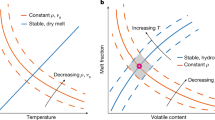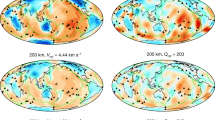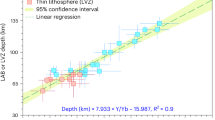Abstract
Geochemical models of melting at mid-ocean ridges—particularly those based on trace elements and uranium-decay-series isotopes—predict that melt segregates from the matrix at very low porosities1,2,3,4,5,6,7,8, of order 0.1%. Some of these models also require that the melt ascends rapidly3,5. But these predictions appear to conflict with seismic data obtained by the mantle electromagnetic and tomography (MELT) experiment9. These data reveal, beneath the East Pacific Rise (at 17 °S), a region of low velocities several hundred kilometres wide, which is best explained by the presence of 1–2% melt, distributed on a grain scale in disk-shaped geometries10. Here I show that these apparently contradictory constraints can be reconciled by taking into account the geometry and resulting permeability of the intergranular network of melt, together with the changing character of the melt as it ascends. A deep, volatile-rich melt with low viscosity and density is mobile at 0.1% porosity, but basaltic melt only becomes mobile at a porosity above 1%. While the volumetric contribution of the volatile-rich melt to the erupted basalts is small, the isotopic disequilibria (except for radium) generated by porous flow of this melt are preserved if melt transport is rapid at the onset of high-productivity melting. Also, because of incomplete extraction, some melt is retained in a broad zone, consistent with the MELT observations.
This is a preview of subscription content, access via your institution
Access options
Subscribe to this journal
Receive 51 print issues and online access
$199.00 per year
only $3.90 per issue
Buy this article
- Purchase on Springer Link
- Instant access to full article PDF
Prices may be subject to local taxes which are calculated during checkout



Similar content being viewed by others
References
Johnson, K. H., Dick, H. J. B. & Shimizu, N. Melting in the oceanic upper mantle: An ion microprobe study of diopsides in abyssal peridotites. J. Geophys. Res. 95, 2661–2678 (1990).
Spiegelman, M. & Elliott, T. Consequences of melt transport for uranium series disequilibrium in young lavas. Earth Planet. Sci. Lett. 118, 1–20 (1993).
Richardson, C. & McKenzie, D. Radioactive disequilibria from 2D models of melt generation by plumes and ridges. Earth Planet. Sci. Lett. 128, 425–437 (1994).
Lundstrom, C. C., Gill, J., Williams, Q. & Perfit, M. R. Mantle melting and basalt extraction by equilibrium porous flow. Science 270, 1958–1961 (1995).
Salters, V. J. M. & Longhi, J. Trace element partitioning during the initial stages of melting beneath mid-ocean ridges. Earth Planet. Sci. Lett. 166, 15–30 (1999).
Lundstrom, C. C., Williams, Q. & Gill, J. B. Investigating solid mantle upwelling rates beneath mid-ocean ridges using U-series disequilibria, 1: a global approach. Earth Planet. Sci. Lett. 157, 151–165 (1998).
Lundstrom, C. C., Gill, J. & Williams, Q. A geochemically consistent hypothesis for MORB generation. Chem. Geol. 162, 105–126 (2000).
Lundstrom, C. C., Sampson, D. E., Perfit, M. R., Gill, J. & Williams, Q. Insights into mid-ocean ridge basalt petrogenesis: U-series disequilibria from the Siqueiros Transform, Lamont Seamounts, and East Pacific Rise. J. Geophys. Res. 104, 13035–13048 (1999).
The MELT Seismic Team. Imaging the deep seismic structure beneath a mid-ocean ridge: the MELT experiment. Science 280, 1215–1218 (1998).
Faul, U. H., Toomey, D. R. & Waff, H. S. Intergranular basaltic melt is distributed in thin, elongated inclusions. Geophys. Res. Lett. 21, 29–32 (1994).
Turcotte, D. L. & Schubert, G. Geodynamics (John Wiley, New York, 1982).
von Bargen, N. & Waff, H. S. Permeabilities, interfacial areas and curvatures of partially molten systems: Results of numerical computations of equilibrium microstructures. J. Geophys. Res. 91, 9261–9276 (1986).
Zhu, W., David, C. & Wong, T.-f. Network modeling of permeability evolution during cementation and hot isostatic pressing. J. Geophys. Res. 100, 15451–15464 (1995).
Wark, D. A. & Watson, E. B. Grain-scale permeabilities of texturally equilibrated, monomineralic rocks. Earth Planet. Sci. Lett. 164, 591–605 (1998).
Faul, U. H. Permeability of partially molten upper mantle rocks from experiments and percolation theory. J. Geophys. Res. 102, 10299–10311 (1997).
Bourbie, T. & Zinszner, B. Hydraulic and acoustic properties as a function of porosity in Fontainebleau sandstone. J. Geophys. Res. 90, 11524–11532 (1985).
McKenzie, D. Some remarks on the movement of small melt fractions in the mantle. Earth Planet. Sci. Lett. 95, 53–72 (1989).
Spiegelman, M. UserCalc: A Web-based uranium series calculator for magma migration problems. Geochem. Geophys. Geosyst. 1, 1999 GC 0000 30 (2000).
Michael, P. Regionally distinctive sources of depleted MORB: Evidence from trace elements and H2O. Earth Planet. Sci. Lett. 131, 301–320 (1995).
Zhang, Y. & Zindler, A. Distribution and evolution of carbon and nitrogen in the Earth. Earth Planet. Sci. Lett. 117, 331–345 (1993).
Green, D. H. & Liebermann, R. C. Phase equilibria and elastic properties of a pyrolite model for the oceanic upper mantle. Tectonophysics 32, 61–92 (1976).
Blundy, J. D., Brodholt, J. P. & Wood, B. J. Carbon-fluid equilibria and the oxidation state of the upper mantle. Nature 349, 321–324 (1991).
Mibe, K., Fujii, T. & Yasuda, A. Connectivity of aqueous fluid in the Earth's upper mantle. Geophys. Res. Lett. 25, 1233–1236 (1998).
Dobson, D. P. et al. In-situ measurement of viscosity and density of carbonate melts at high pressure. Earth Planet. Sci. Lett. 143, 207–215 (1996).
Hunter, R. H. & McKenzie, D. The equilibrium geometry of carbonate melts in rocks of mantle composition. Earth Planet. Sci. Lett. 92, 347–356 (1989).
Galer, S. J. G. & O'Nions, R. K. Magmagenesis and the mapping of chemical and isotopic variations in the mantle. Chem. Geol. 56, 45–61 (1985).
Plank, T. & Langmuir, C. H. Effects of the melting regime on the composition of the oceanic crust. J. Geophys. Res. 97, 19749–19770 (1992).
Kelemen, P. B., Hirth, G., Shimizu, N., Spiegelman, M. & Dick, H. J. B. A review of melt migration processes in the adiabatically upwelling mantle beneath oceanic spreading ridges. Phil. Trans. R. Soc. Lond. A 355, 283–318 (1997).
Yaxley, G. M. Experimental study of the phase and melting relations of homogeneous basalt + peridotite mixtures and implications for the petrogenesis of flood basalts. Contrib. Mineral. Petrol. 139, 326–338 (2000).
Asimow, P. D. & Stolper, E. M. Steady-state mantle–melt interactions in one dimension: I. Equilibrium transport and melt focusing. J. Petrol. 40, 475–494 (1999).
Nielsen, R. L., Sours-Page, R. E. & Harpp, K. S. Role of a Cl-bearing flux in the origin of depleted ocean floor magmas. Geochem. Geophys. Geosyst. 1, 1999 GC 0000 17 (2000).
Hirth, G. & Kohlstedt, D. L. Water in the oceanic upper mantle: implications for rheology, melt extraction and evolution of the lithosphere. Earth Planet. Sci. Lett. 144, 93–108 (1996).
Wood, B. J., Blundy, J. D. & Robinson, J. A. C. The role of clinopyroxene in generating U-series disequilibrium during mantle melting. Geochim. Cosmochim. Acta 63, 1613–1620 (1999).
Acknowledgements
Discussions with S. Eggins, D. Green and H. O'Neill are gratefully acknowledged, as well as pre-publication access to a G3 article by M. Spiegelman. Reviews by T. Elliot and M. Spiegelman helped to shape this manuscript.
Author information
Authors and Affiliations
Corresponding author
Rights and permissions
About this article
Cite this article
Faul, U. Melt retention and segregation beneath mid-ocean ridges. Nature 410, 920–923 (2001). https://doi.org/10.1038/35073556
Received:
Accepted:
Issue Date:
DOI: https://doi.org/10.1038/35073556
This article is cited by
-
Deglaciation-enhanced mantle CO2 fluxes at Yellowstone imply positive climate feedback
Nature Communications (2024)
-
Seismic evidence for partial melt below tectonic plates
Nature (2020)
-
Melt-induced buoyancy may explain the elevated rift-rapid sag paradox during breakup of continental plates
Scientific Reports (2018)
-
Electrical conductivity of hydrous silicate melts and aqueous fluids: Measurement and applications
Science China Earth Sciences (2016)
-
Grain boundary wetness of partially molten dunite
Contributions to Mineralogy and Petrology (2016)
Comments
By submitting a comment you agree to abide by our Terms and Community Guidelines. If you find something abusive or that does not comply with our terms or guidelines please flag it as inappropriate.



